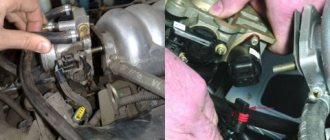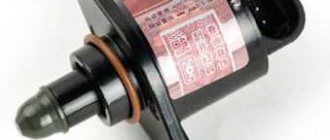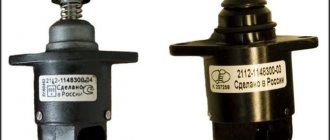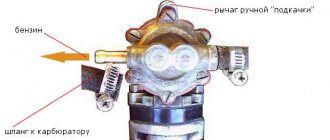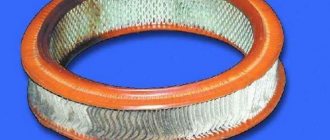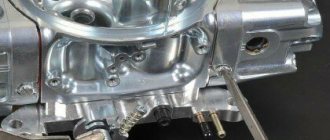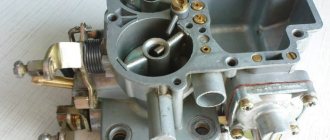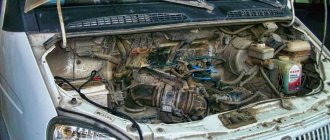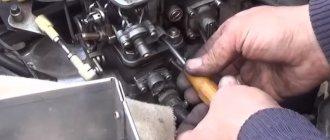The engine starts and stalls: troubleshooting
So, if a similar problem appears, then it is necessary to take into account a number of features. First of all, the operation of the internal combustion engine after startup will be influenced by the following factors:
- fuel supply;
- air supply;
- spark on spark plugs (for gasoline internal combustion engines);
- correct operation of glow plugs (for diesel engines);
- proper operation of the ECM and electronic sensors;
With that said, you should first start by checking the main possible causes:
- Quite often, malfunctions in the operation of the alarm system and the anti-theft system can cause the engine to fail to operate after starting. In other words, the immobilizer does not turn off and continues to block the start of the internal combustion engine, which is its main function to prevent vehicle theft. If the alarm blocks the engine, then you need to check the operation of all elements, try to reset the error, turn off the anti-theft system, etc.
- Problems with the IAC and idle air valve often arise due to contamination of these elements. You should also pay attention to the cleanliness of the throttle valve. As for the crankshaft sensor, incorrect data that it transmits to the ECU can cause the engine to stall immediately after starting.
- Poor quality fuels and lubricants can also cause problems. As a rule, problems begin in cases where low-grade fuel was filled or the engine uses motor oil that does not meet the recommendations/has lost its properties.
- A faulty fuel pump, air leaks in the fuel line, the formation of air pockets and dirty fuel filters do not allow creating the required pressure in the power system or supplying fuel in the required volume.
- The air filter and its contamination leads to the fact that the working mixture is significantly over-rich. In other words, the engine does not have enough air to burn fuel, and the spark plugs flood.
- Problems with ECM sensors (EGR sensor, oxygen sensor, DPKV, etc.) can lead to both unstable engine operation at idle and a complete engine stop after starting.
Now let's look at the most common problems and how to fix them, looking at them in detail.
- First of all, the culprit may be the low level of fuel in the gas tank and its quality. If gasoline or diesel fuel runs out, then the engine will start using the remainder in the power system, but further operation will be impossible.
Why does engine 5 on Gazelle Euro 3 stall without movement?
Try changing the tips and check the electrical wiring of the air vent. You may need to clean the injectors and fuel filter. There are a lot of options, it’s best to diagnose it first.
Or the fuel supply is incorrect - check the fuel system (the fuel pump is not pumping enough, and so on). Or the engine management system is being clever - check the ECU. The third option is a curve oxygen sensor/Lambda sensor. You could search for more, but these are the only ones that immediately came to mind.
The rpm only fluctuates at idle from 500 to 1000, and even stalls when cold. What to do?
Your problem can be described in a nutshell as an “air leak”. The most common places for suction: injector seals, IAC gasket, crankcase ventilation system pipes. You can search either with smoke or with carburetor cleaner (spray at the site of the suspected leak).
1 Good answer
Why does the motor cultivator sneeze? And stalls under load
The ignition is almost certainly misregulated. Try unscrewing the spark plug: if it’s wet, adjust the ignition. And if it’s dry, it means there’s a fuel problem (no gasoline, the tap is turned off, there’s a blockage—it’s impossible to say what exactly without looking at the patient). I once had a gas line clogged with a piece of garbage - I fiddled with it for several days until I found it :)
4 Good answer
Metallic knocking sound when the engine is running. The speed fluctuates xx. It often stalls. Doesn't work. The more electronics are turned on, the lower the speed. What's broken?
It’s possible that the liner rotated, you can guess endlessly, you need at least a video of the engine working, what car? As for the electrics, most likely there is a bad charge coming from the generator.
2 Good answer
Why does the engine seem to choke when you sharply press the gas pedal?
In this case, you should start by checking the spark plugs. Quite often the problem can be solved simply by replacing the spark plugs. If this does not help and the “check” light on the dashboard is on, you should conduct computer diagnostics of the engine. This procedure almost always allows you to significantly reduce the list of suspected faults and quickly eliminate the breakdown.
Source
Why does a gazelle start and stall?
During the operation of a car, a common situation is that after turning the ignition key, the car starts, the engine starts to work and stalls after a few seconds. As a rule, 3-5 seconds pass from the moment of starting to stopping the internal combustion engine. Before the engine stops completely, engine vibrations are also noticeable, the power unit shakes and operates very unstable.
This happens as a result of a decrease in speed, the resonance effect of a rotating crankshaft, etc. When you try to start the engine again, the engine may no longer start, or the situation described above may repeat again.
The reasons for this problem vary. The main thing is that if the car starts and stalls, this indicates that in-depth diagnostics are needed. Next we will talk about what to do in such a situation, as well as how to find the reason why the engine stalls after starting.
Read in this article
Gazelle stalls
#1 Dmitry_D
- Garage workers
- 7381 messages
Please tell me what could be the reason.
Gazelle with internal combustion engine ZMZ 405 euro3 with electronic throttle. A floating malfunction has arisen, which consists of the following: for no reason at all while driving it jams at 2000 rpm, does not respond to the gas pedal, and stalls after 10 seconds (if you turn on neutral). The car can drive for 2-3 days without problems, and then within 5 kilometers it will fail 5 times. Diagnostics show nothing, replacing the throttle did not help. It’s unlikely the fuel pump, because it appeared with different fuel pumps, although the problem rarely appeared before, 4 times in 5 years, 25 times in the last 2 months. It’s unlikely the ignition coils, since the engine doesn’t fluctuate and runs smoothly. Could the brain block itself be the cause? PS I remembered that in extreme cold, during a cold start, sometimes the engine also jammed at 2000 rpm, but the car just stalled.
I really hope for help, because we have no more thoughts left. The last one is an assumption about “brains”.
Source
Gazelle starts and stalls 406 carburetor
In this article we will take a closer look at the situation when a carburetor engine of a passenger car (VAZ 2108, 2109, 21099, 2105, 2107 and their modifications) starts and stalls due to a carburetor malfunction. Malfunctions of carburetors 2105, 2107 Ozone, 2108, 21081, 21083 Solex and their modifications will be considered. — The engine starts, runs for a few seconds and stalls, repeated starts are unsuccessful. — The engine starts with difficulty, after running for a short time it stalls, after restarting it starts and runs.
— The engine starts and immediately stalls, starts again and stalls again, and so on several times, but then it still starts working.
Causes of malfunction
There is no fuel in the float chamber
Pump it up using the manual pump lever on the fuel pump.
The fuel pump or power system may be faulty. Remove the hose from the carburetor fuel supply fitting and press the manual primer lever on the fuel pump several times. A strong pulsating stream of gasoline should come out of the hose hole. If it is missing or weak, check the fuel pump or power system.
VAZ fuel pump check
The strainer at the carburetor inlet is clogged
Remove it by unscrewing the cap, clean it (you can use a toothbrush), rinse with acetone or gasoline and blow with compressed air. At the same time, clean the filter seat in the carburetor cover.
details of mesh filters for fuel purification of carburetors 2108, 21081, 21083 Solex, 2105, 2107 Ozone
The solenoid valve is faulty or the fuel jet of the idle system is clogged
Check whether the solenoid valve or the idle air system fuel nozzle holder has become loose due to any circumstances. Turn it on. Remove the wire from the valve and then put it back on. You should hear the click of the valve being activated. If it is not there, we connect a piece of wire plus the battery and the valve outlet. There is no click - we change the valve. There is a click - we check the EPH system.
carburetor solenoid valves 2108, 21081, 21083 Solex, 2105, 2107 Ozone
Check the serviceability of the valve itself by unscrewing it from the carburetor and removing the fuel jet from it. The jet should be carefully inspected for contamination and deformation. We also check the ease of movement of the valve shut-off needle, the presence and integrity of the rubber O-ring on the valve body.
carburetor solenoid valve device
Unscrew the idle air system fuel nozzle holder (on carburetors with a holder instead of a solenoid valve), rinse, clean the fuel nozzle and blow with compressed air.
“Suction” of foreign air into the carburetor
In this case, the fuel mixture is lean. If the engine starts and immediately stalls, it is most likely very lean. The image shows probable places where foreign air is “sucked in” on the 2108 Solex carburetor.
places where foreign air is likely to “suck” into the carburetor 2108, 21081, 21083 Solex
Read more about the “suction” of foreign air in the article “Suction of foreign air into the carburetor.”
Fuel system and ignition
You should start your search by inspecting the fuel system. Its poor quality of work creates an unpleasant situation in which the car stalls while driving. Visual diagnostics are usually carried out in stages, and should begin as follows:
- Check the presence of gasoline in the tank, no matter how trite it may sound. Very often, the sensor located on the dashboard displays incorrectly due to its own malfunction. The gas ran out and that's why the car stalled.
- The fuel pump may fail and stop pumping fuel into the engine. It makes the characteristic buzzing sound of an electric motor, so you can check it by ear by simply turning on the ignition. To be more convincing, it would be better to connect a pressure gauge to it, which will show the pressure created by the pump; it should be about 2.7 atmospheres.
- A heavily clogged filter can also prevent fuel from entering the engine. Inside its body there is a filter element, which becomes clogged with particles of debris contained in gasoline. To check it, just remove the hose coming from the element and turn the starter, and a stream of gasoline should flow out of it. If this is not the case, then it is clogged and needs to be replaced, which is why the car will not start.
- Fuel injectors also tend to become clogged due to poor quality gasoline or diesel fuel. You can check their operation yourself by removing the ramp. Move it away from the car and turn the starter. A flammable mixture should be sprayed from their nozzles. The opposite case is when there is no spraying. This means they have failed, so the car will not start.
- The spark formation system for igniting the fuel, or rather its absence, can cause the engine to stall. The most vulnerable elements of the ignition system are spark plugs and high-voltage wires. They are responsible for the quality and presence of a spark in the combustion chamber. Spark plugs must have the required gap between the electrodes and be free of any deposits on the working surface. The absence of these conditions prevents the formation of a spark, without which the power unit stops working. The insulation on high-voltage wires wears out, through which electrical charges begin to make their way to the engine crankcase. To check the formation of a spark, you need to unscrew the spark plugs and, placing them on the valve cover, turn the crankshaft with a starter. The spark should be clearly visible on the electrodes of the spark plugs; if this is not the case, then they need to be changed.
- The ignition system is significantly influenced by the electronic control unit (ECU) of the power unit, which interacts with various sensors. Failure of some sensors will prevent the engine from starting. The main influence on the ECU is exerted by the crankshaft speed sensor and camshaft position sensors. Without receiving a signal from any of them, the ECU will not allow a spark to form on the spark plugs, so the car will not start. Here it is worth checking the connectors of the contacts of these sensors; they can fly off while driving, as a result of which the engine stalls while driving. It is difficult to independently check their serviceability; to do this, you need to use a tester and measure the sensor readings. In this case, the right decision would be to contact a specialized car repair service, where they will quickly identify the breakdown and fix it.
How does the ZMZ 405 idle speed sensor work?
In carburetor engines, the problem of enriching the mixture when starting the internal combustion engine was solved by a starting handle and shims. With the advent of electronic ignition, this is done by the idle air regulator in conjunction with other sensors and the computer. Its operating principle is as follows:
- IAC calibration is performed by the ECU controller automatically after detecting this sensor in the system;
- in fact, the IAC is a stepper motor with a conical needle in a special hole in the throttle valve bypass channel;
- The IAC contact does not transmit any signals to the “brain” of the machine, but receives them from the controller, therefore it is not a sensor, but an actuator - an electric valve;
- in turn, the on-board computer “sees” that there is not enough air in the fuel mixture based on the signals from the mass air flow sensor, compared with the signals from the air flow sensor;
- Voltage is applied to the XX regulator, the needle leaves the channel, and the missing amount of air enters the mixture for mixing.
Gas 3110 won't start, injector 406 stalls
The car stalled while driving at high speed and will not start. The starter turns, but there is no response. After much torment, the car finally started, but when moving, the car jerks, hesitates, does not pull, and after some time stalls. This very often occurs in hot weather on the highway. There may be several reasons: - the fuel pump has overheated, - the RTD fuel pressure regulator does not work (also overheating), which leads to increased pressure in the fuel system, - a break in the crankshaft sensor,
There are several things you can try to resolve these issues. 1. Using the ignition key, turn on the fuel pump until it is completely processed three times. 2. Press the accelerator pedal to the floor and turn the ignition switch to start. 3. Under the hood, remove one of the gasoline hoses (pre-prepare an empty container for draining the fuel). Do not allow gasoline to get into the exhaust manifold; a fire may occur. We remove the hose from the tube gradually, thus releasing excess pressure. The fuel pressure regulator should be kept at idle. 2.7 atm., and when re-gasping up to 3 atm. If the RTD holds 4 atm. and higher, the ECU may turn off the injectors due to the mixture being too rich and the pressure being too high.
You can check the RTD with a conventional tire inflator. Venting air at 3 atmospheres indicates normal operation of the RDG. (show video of pressure measurement) 4. Cool the fuel pump with water or a cold cloth. 5. If you cannot hear the pump operating, then perhaps there is no power supply to it or fuse number 9 in the right fuse block has blown.
Perhaps the relay does not work and does not supply voltage to the EBN. In this case, remove the relay; it is located in the right rear part of the engine compartment, engine control relay unit. The relay may be brown or orange. Close contacts “30” and “87”. If the pump starts working, replace the EBN relay. Otherwise, check the green-violet wire on the EBN. If the wire is intact, replace the pump.
You can check the functionality of the EBN switching relay itself: a) Check fuses No. 9 and No. 10, in the right fuse block. b) Remove the relay c) measure the voltage at contact “+30” and “-85” U=12v d) If there is no voltage, then measure at “+30” and the vehicle’s ground. If U=12v is present, you need to check whether the wire (brown-green and red) is broken. 6. Check the crankshaft position sensor for a break. This is the only sensor that, if it is faulty, will not start the car.
The engine stalled while driving and the gazelle does not start
I was driving home from work on Christmas Day. There was a noticeable minus on the street. 10 km from home, at a constant speed of about 110 km/h, the engine began to sharply lose speed. It only got worse when I pressed the gas. I turned on the emergency lights and stopped. I turned off the engine. Tried to start it again. He grabs it and starts twisting. then it seems like there is a strong detonation and it stalls. There is a strong smell of gasoline under the hood. The car was towed to the house. I took the battery home and fully charged it. Changed the spark plugs. The old ones were completely black and flooded. Attempts to start the next day did not bring any results. Everything happened again. It's warmer now. tried to start again. The starter has difficulty cranking the engine. Initially there was a suspicion that the chain had jumped. I removed the cover, the marks are in place. I discovered one unpleasant moment. With the spark plugs unscrewed, you cannot turn the crankshaft pulley by hand. It turns with a key, but sticks tightly in some positions. What could have happened?
The antifreeze is in place, the oil level is visually normal, no emulsion is visible, the fuel pump is working, there is gasoline, there is a spark.
I was driving home from work on Christmas Day. There was a noticeable minus on the street. 10 km from home, at a constant speed of about 110 km/h, the engine began to sharply lose speed. It only got worse when I pressed the gas. I turned on the emergency lights and stopped. I turned off the engine. Tried to start it again. He grabs it and starts twisting. then it seems like there is a strong detonation and it stalls. There is a strong smell of gasoline under the hood. The car was towed to the house. I took the battery home and fully charged it. Changed the spark plugs. The old ones were completely black and flooded. Attempts to start the next day did not bring any results. Everything happened again. It's warmer now. tried to start again. The starter has difficulty cranking the engine. Initially there was a suspicion that the chain had jumped. I removed the cover, the marks are in place. I discovered one unpleasant moment. With the spark plugs unscrewed, you cannot turn the crankshaft pulley by hand. It turns with a key, but sticks tightly in some positions. What could have happened?
The antifreeze is in place, the oil level is visually normal, no emulsion is visible, the fuel pump is working, there is gasoline, there is a spark.
When I removed the valve cover and the front cylinder head cover, the damper (at least the upper one) was in place. How likely is the lower damper to break?
Option number 3. The oil pump is stuck, dare I guess?
did the mark on the pulley also match?
Option number 3. The oil pump is stuck, I daresay
did the mark on the pulley also match?
All the marks coincided, which is surprising) TDC, marks on the camshafts, mark on the pulley, 20 tooth of the pulley opposite the DPKV.
Source
Other reasons why the engine stalls when hot
In addition to the above material, I would like to note a number of malfunctions that lead to a sudden stop of a hot engine while driving. The unit may stall while driving if the timing belt or chain is broken. This situation means that in most cases the power unit will require expensive repairs, since as a result of a break the valves are bent, piston defects and other damage to engine elements occur.
If the engine stalls while driving through deep puddles or other water obstacles, then there is a high probability of water getting into the cylinders or the elements of the ignition system getting wet. In the first case, water enters the combustion chambers through the air intake. Since water is incompressible, the engine is severely damaged, connecting rods bend, cracks appear in the cylinder block, etc. After a water hammer, there is usually a need to overhaul the engine. In the second case, the problem is not critical, since after removing the moisture, the functionality of the ignition system and power unit can often be restored.
Also, a car may stall when hot if there is too little fuel in the fuel tank. Quite often the engine stops when driving uphill. The fact is that during a long climb, the car is in a position for a long time when the fuel tank is tilted and the fuel level is not enough to supply through the fuel intake. It is quite obvious that in this case the engine will stall.
What's the result?
As you can see, there are quite a few reasons why the engine starts running and stalls after starting. However, most of them are usually associated with the fuel system, ignition system and electronic control system.
In this case, it is appropriate to talk about low compression in the cylinders due to the fact that the engine has exhausted its service life (the cylinder walls, rings, etc. are worn out), that is, the unit needs major repairs. Compression can be measured at a service station or yourself using a compression meter.
The engine stalls at idle: what to check. Possible causes of malfunction on engines with a carburetor, injector, and diesel power plants.
At idle the speed “floats”: why does this happen? The main malfunctions associated with idle speed on gasoline and diesel engines.
The main reasons why the engine starts to stall after warming up. Frequent problems of carburetor and injection engines, fault diagnosis.
The reasons why, after pressing the gas pedal, dips occur and the engine begins to choke. Gas engine failures when switching from gasoline to gas.
Why the engine may not pick up speed: gasoline engine, diesel unit, car with LPG. Fault diagnosis, useful tips.
Reasons why the engine may stall when you press the brake. The power unit stalls during sudden braking, when the clutch and brake are depressed, etc.
Why doesn't the injection Gazelle 405 start? Main reasons
There are various difficulties with cars, unfortunately the Gazelle 405 injector won’t start
for some reason in most cases. Drivers begin to rack their brains, but from time to time it is impossible to find a solution to the problem in any case.
At the moment, several more possible breakdowns will be considered, during which the car will not start.
When this happens, the first thing our client needs to do is look at the wires, spark plugs, rail pressure and injectors. In most cases, the Gazelle 405 injector will not start specifically because of the spark plugs, so just change them. Alas, when problems arise that are more serious than candles.
The most common breakdowns
The most common malfunctions of the idle speed sensor:
- Power failure. This usually happens due to faulty wiring or oxidized electrical contacts. This problem is quite difficult to diagnose due to its inconsistency.
- Rod malfunction due to contamination.
- Electric motor malfunction.
- Worn O-ring.
Rod wear. The shutter movement of a properly functioning idle air control valve should occur without biting or slipping in the gear-screw drive. To assess the condition of the rod and gear-screw, you need to understand how to disassemble the idle air control valve.
Rod contamination is the most common malfunction. When using the device, dirt accumulates in the throttle valve area. If this part has been cleaned for a long time, it is quite possible that problems with the IAC arose precisely because of carbon deposits on the rod. To check the IAC it is necessary to remove it from the throttle assembly. Carburetor cleaner is suitable for treatment.
If there is too much carbon on the rod, it can be dangerous. Because of this, the load on the electric motor increases, which in turn can damage the elements of the IAC control system, which costs more than four hundred euros.
Troubleshooting and performing repairs when the car stalls while driving
This is the majority of problems you cannot solve on your own. You must contact a specialized service center. Especially do not waste time on repairs yourself when it comes to the on-board computer. Its firmware and diagnostics are only possible using special equipment.
When there is a need to change the idle speed sensor, just find its location, open the machine operating book and read in this section about replacing it. In reality > myth the process resembles unscrewing one nut and tightening another. The service will cost 500 rubles, but our client can do it at home quickly and free of charge. The following processes are also performed:
- disassembling the fuel pump and cleaning it from dirty deposits;
- replacing fuel filters that do not allow the required amount of gasoline to pass through;
- replacing spark plugs and high-voltage wires, which may cause the car to stall;
- replacing the distributor cap along with the slider and other internals;
- Finding and replacing non-working fuses and relays.
This is an impressive list of actions you can perform at home or in a garage without the involvement of specialists and without the huge costs of repair work. It is enough to arm yourself with a car repair and maintenance book, the Internet and a few hours of your time. Often, with a sequential analysis of situations, it is possible to find and correct the problem.
Various forums will also help you with repairs; they provide a lot of useful information on how to actually repair those other problems. If you go into the complex accounting software (software) of modern cars, it is only worth it to the extent where there is an option to stop and return everything to the area.
The carburetor or injector does not start on a cold gazelle 406 engine
A Gazelle with a 406 carburetor and injection engine does not want to work for various reasons. Most of the issues are related to cold temperatures in winter.
↑
Common reasons why a gazelle won't start
The Gazelle will not start, there are different reasons:
- The fuel system and its associated components are faulty. The crux of the problem relates to the cylinders and valves.
- The ignition system has suspected problems.
- Poor starter and battery performance.
- The uniform air supply is interrupted.
- There are malfunctions in the control unit and its sensors.
All elements of the fuel system will have a significant impact on engine starting. The ZMZ 406 engine for the gazelle is available in injection and carburetor versions. In the injection version, injectors are installed, obviously they can be the suspected source of the problem. There was no cleaning for a long period of time. They are in a dirty state. They should be cleaned or replaced.
What to do if the Gazelle stalls while driving?
If the Gazelle stalls while driving, then the first thing you need to do is look at the fuel, or rather its supply.
It is necessary to inspect the engine compartment for fuel leaks. It happens that due to vibrations, the fixing bracket unscrews and the tube from the injection pump to the ramp bursts.
Even a small crack in the tube will be enough for the pressure in the system to drop and the engine to stop working. This phenomenon is usually accompanied by a yellow check.
If everything is in order with the tube from the injection pump to the ramp, we recommend continuing to inspect the fuel system and pay attention to the fuel filter housing. Sometimes it happens that its top cover fails and air begins to leak through it.
Recommendations
Comments 60
And how did the epic end? I have similar syndromes =(
remove the chip from the mass air flow sensor and start it! If it doesn’t help, then put it back on and take it off. Even if the pump dies, then at xx it will create the necessary pressure, but in power mode it will not work! pull the chips and look!
So, I’ll check with the MAF tomorrow morning, but if I reset the MAF, it generally stalls immediately after starting, but sometimes it lasts for 5-20 seconds, but then it dies immediately. What else to watch? I installed the new phases, for some reason they are shorter than the old one, by 0.2 cm somewhere, +- 0.1. Rxx seems to be working, I checked it as a direct plus, according to the book it was written to check the central socket and the side ones (in turn), it closes, I check the two outer ones, it also closes, although nothing is written about the outer sockets... The mass air flow sensor is also intact, it seems like it gives out 2.80 ohms and not the norm of 2.6 as it should be...what is the reason?
according to IAC - everything depends on the ECU firmware! DPRV - question to the manufacturer DMRV - it is still a sensor and it also has brains!
filter, there’s nothing else, and maybe a fuel filter, but then it won’t work
I changed the filter, the old one was spinning the same way, they blamed it, but it didn’t turn out that way...
Guys, I’m sorry that it’s not much on topic, but I hope that there’s nothing wrong with it, on the contrary, at idle it works for me, when I press the gas pedal, it feels like there’s either not enough fuel, or it’s terribly overflowing, periodically this overflow or The lack of fuel disappears and the car drives quite normally. What could be, where to go? Thanks for understanding. Machine 3102 with ZMZ 406.
I had this happen because of the injectors.
Do you think it's worth cleaning? Or should I change it anyway?
Cleaning didn't help me, I changed it
Thank you. I'll try to clean it tomorrow
I agree with what was said above on my own - after replacing the filters, if that doesn’t help, try to measure the pressure of the fuel line. 1 the pressure of the pump without a fine filter (in front of the ramp) should be at least 4.5 kgcm 2 at idle, the pressure in the rail should be at least 2.5 kgcm3 most likely The check valve on the fuel rail failed, I replaced about a dozen at one time until I found an old model - a dismountable one - all the problems with idle were gone, good luck
really? because if I give it gas, everything is perfect, it doesn’t hold idle even for 5 seconds, it stalls...
It was due to a clogged filter in the tank (pyramid)
if the fuel pump makes a lot of noise, it means it will soon grunt, I had this happen, you can last a month on this, but apparently it needs a replacement
Gas 3110. ZMZ 406 (injector). Doesn't hold idle, starts normally, if you press the pedal it's also OK. The fuel pump is humming, you can hear how good it is humming. Compression is 12 points, all sensors have been checked and replaced, the injectors have also been checked and blown out. The camshafts are honestly as they should be, and needless to say, they have jumped a tooth. What is the reason? The idle speed sensor works. The damper also seems to say everything. Where should I go? We haven't looked at the phase sensor yet. And could this be due to the pump? Should it make a loud noise?
Comments 60
And how did the epic end? I have similar syndromes =(
remove the chip from the mass air flow sensor and start it! If it doesn’t help, then put it back on and take it off. Even if the pump dies, then at xx it will create the necessary pressure, but in power mode it will not work! pull the chips and look!
So, I’ll check with the MAF tomorrow morning, but if I reset the MAF, it generally stalls immediately after starting, but sometimes it lasts for 5-20 seconds, but then it dies immediately. What else to watch? I installed the new phases, for some reason they are shorter than the old one, by 0.2 cm somewhere, +- 0.1. Rxx seems to be working, I checked it as a direct plus, according to the book it was written to check the central socket and the side ones (in turn), it closes, I check the two outer ones, it also closes, although nothing is written about the outer sockets... The mass air flow sensor is also intact, it seems like it gives out 2.80 ohms and not the norm of 2.6 as it should be...what is the reason?
There may be several reasons why the car engine stalls when you press the gas after idling. But the good news is that each reason that the engine stalls when you press the gas has its own conditions, additional symptoms, so each of these reasons is not difficult to determine. Therefore, it is important to understand the situation when this problem occurs. Therefore, let's take it in order, in order of prevalence, of the reasons for the engine stopping while trying to start!
The engine stalls when you press the gas only in the morning or in humid weather. Cause: Moisture on the distributor cap
If the problem occurs only in the morning, when the engine is still cold, or in rainy or cloudy weather, then this means that the cause is moisture on the ignition distributor cap. This happens because at night, especially when it rains, condensation occurs inside the distributor cap. And the shape of the ignition distributor cap of your car model may be such that it allows the electric current inside the distributor to misfire, as a result of which the electricity simply does not reach the spark plugs.
Car service to help
Read:
If you decide to contact a car service, first of all carry out engine diagnostics. Few inexperienced drivers understand the cause of the breakdown. At the same time, the Gazelle 405 may not start for various reasons, and some of them can be resolved on the spot.
When you finally take your car to a car service center, at least consult with its employees; most likely they will tell you what the problem is.
It is very important to know absolutely everything about your car.
to protect yourself on the road and do extra work. Sooner or later, any part can break, but it will be better if you are prepared for this.
Causes
The main reasons for this situation lie in the following motor components:
- fuel supply or ignition is stopped;
- the gas distribution mechanism adjustments have gone wrong;
- There was a breakdown of internal parts of the power unit.
To identify a broken part, it is worth analyzing the behavior of the vehicle before the breakdown occurred.
Thanks to modern electronics, before a final breakdown, an alarm signal is displayed on the dashboard, which informs the driver about possible problems. At the first signal, it is worth immediately carrying out diagnostics and eliminating the malfunction at the initial stage.
If this is not done, then you can only wait for future problems, in which the engine suddenly stalls while driving, after which it does not start.
Common Causes
The Gazelle 405 injector does not start for various reasons. There could be a hundred of them, or even more, since there are simply unrealistically many details. However, injectors and spark plugs
. If the latter can be bought at any auto parts store, and even a less experienced driver can replace them, then problems may arise with the former.
The fact is that it is very difficult to determine that in such a situation in the Gazelle 405 it was the injectors that broke
.
They are often the last thing thought of.
, so a lot of time is lost diagnosing the breakdown. But there is another option - problems with the injector. Fortunately, it doesn’t always need to be repaired; sometimes all you need to do is wash the part and the car will start. In any case, you will be very lucky if the breakdown is not serious, since the Gazelle 405 can take forever to repair and still not understand the reasons for the breakdown.
{banner_content}
Faulty injection pump
The reason that the car does not start may be a breakdown of the high pressure fuel pump. The injection pump fails due to the following reasons:
- poor quality fuel;
- water and dirt in fuel;
- long-term operation of the car with air leaks.
The first two reasons for fuel pump failure are obvious. Why does the fuel injection pump break down due to air leaks? The fact is that modern common rail system pumps do not have a separate lubrication system and are lubricated with diesel fuel.
And when there is air in the fuel, the injection pump begins to run “dry”, which is why the friction between the pump elements increases significantly and over time it begins to drive metal shavings.
These metal shavings can cause fuel injectors to fail over time. If you need to turn the starter for a long time to start the engine and if the engine runs unevenly and with vibrations, then most likely this indicates an air leak.
In order not to destroy the fuel system and avoid expensive repairs, we recommend eliminating this air leak as soon as possible.
Also, the cause of poor starting of the internal combustion engine can be a jammed check valve on the fuel injection pump. This happens rarely, but it does happen. Therefore, we recommend that you check it as well.
see also
Comments 13
This happened when there was a problem with the phases! But no gases go into the coolant reservoir?
3828 number of the TOZh sensor for the 406 engine
100 poods, the temperature sensor is dead, which on the thermostat housing faces towards the radiator.
To check it, I think you need to screw in the same one, only a new one.
The owner of this motor says that it was installed new. I don't think it's about him.
but the engine won't start after you turn it off
It starts after it cools down to 55 degrees.
Then without a doubt, this is the sensor I'm talking about, I had the same thing. You just need to take it from the 406 motor, the price is 200 rubles. Sometimes from 405 or 402, but they do not work correctly.
The owner of this motor says that it was installed new. I don't think it's about him.
So what if there’s such a new percentage of marriages, mom, don’t worry. Yes, and look for 406, because... available on 405 and 409.
To check it, I think you need to screw in the same one, only a new one.
You just need to turn it off. Mosk will work according to average indicators and if it is successful, then the problem has been found.
Adjustment
Fuel consumption directly depends on the adjustment, even if the carburetor is absolutely working.
There is only one external adjustment in the device - idle speed. How to do it correctly:
- We start the engine and warm it up to a hot state, then perform adjustments at idle speed;
- We unscrew the quantity screw (a large screw with a spring) and the quality screw until the engine reaches maximum speed;
- By evenly tightening both screws, we find the position when the engine starts to work with minimal interruptions;
- Using the quantity screw we set the speed to a slightly higher speed, at this point using the quality screw we achieve stable operation of the motor, but at the same time we need to try to keep the quality screw unscrewed to a minimum (as far as possible);
- Having adjusted the quality, turn the quantity screw until the optimal idle speed is obtained (700-750 rpm).
Failure Traits
If the engine malfunctions, the following characteristic features will occur:
- The car stalls when you turn on devices or other equipment powered by the on-board network.
- The operation of the BC is disrupted due to voltage surges.
- When a load is applied, the engine stops immediately.
- You can hear the sounds of the alternator belt spinning.
- If the operation of the generator is disrupted, then as the speed increases, the headlights begin to burn better and brighter.
Sometimes these problems are not related to the malfunction of the generator, but to other problems of the car.
Replacing the sensor
Replacing the sensor is possible in a garage, but if the driver does not have the proper skills and knowledge of how the car works, you should entrust the replacement of the IAC to a car service center to avoid making mistakes.
Replacement occurs as follows:
- It is necessary to completely turn off the ignition and remove the key.
- Then remove the negative terminal from the battery.
- Using a thin flat screwdriver, unclip the block clamp and disconnect the regulator connector.
- Next, using an ohmmeter, we measure the resistance readings of the sensor windings. A faulty regulator will have a resistance on each of the two windings in the range of 10–15 ohms.
- If after measurements the sensor turns out to be faulty, then it must be removed from the engine and replaced with a new one.
This way the faulty regulator is replaced. It is important to replace it with exactly the same model that was installed previously.
Car repair sable.
In this article we will examine the topic of poor engine starting in as much detail as possible. In this article we will talk about 4216 engines, but don’t worry if you have, for example, a 406 engine, we have no doubt that our article will also help you.
If your car has stopped responding to turning the key and does not even try to “wake up” somehow, do not rush to tow your vehicle to a car service center, read our article to the end and most likely you will eliminate the cause yourself. Just follow our advice.
So, let's look at the main symptoms.
The car is trying to start, but something is missing.
The engine “clicks” and doesn’t even try to start.
The car does not respond at all to turning the ignition key.
1) First of all, you must make sure how much power your battery has. (Well, here every motorist will understand this, by the characteristic sound, whether the battery is pulling or not. Elementary, press the sound signal, if the beep is heard, as usual, without “hoarseness,” then the battery is in perfect order.)
Intake air heating coil
For the fuel mixture to ignite, it must be at a certain temperature. And in order for the mixture to reach the desired temperature, Cummins ISF 2.8 engines have an element called an intake air heating spiral (candle).
This engine element starts working at low temperatures. It is located in the engine intake manifold and starts working after turning the ignition key. In principle, in the summer, when it’s warm outside, you can do without this detail. But on frosty days, starting the engine with the intake air heater not working will be very problematic.
Therefore, in the cold season, the first thing you need to do is check whether the intake air heating coil is working. This is easy to do - when the spiral is running, the intake manifold should be warm.
It is necessary to inspect the contacts of the spiral and the wires going to them. It often happens that the wires simply break. But sometimes it happens that the spiral itself fails. In this case, only replacing it will help.
Gas distribution mechanism (GRM) and breakdown of internal parts of the power unit
The gas distribution mechanism consists mainly of a crankshaft with a group of pistons and camshafts with intake and exhaust valves. Driven by belt or chain drive.
Each of the shafts must have a certain position during engine operation, but it also happens that a large wearout of the belt, chain or gear with sprockets leads to the fact that any shaft begins to either advance or be late in performing its functionality.
This is called incorrect ignition timing adjustment.

